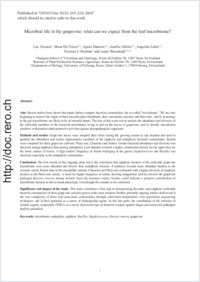Microbial life in the grapevine: what can we expect from the leaf microbiome?
- Vionnet, Léo Changins School of Viticulture and Oenology, Nyon, Switzerland
- Vrieze, Mout De Institute of Plant Production Sciences, Agroscope, Nyon, Switzerland - Department of Biology, University of Fribourg, Switzerland
- Dutartre, Agnès Changins School of Viticulture and Oenology, Nyon, Switzerland - Department of Biology, University of Fribourg, Switzerland
- Gfeller, Aurélie Changins School of Viticulture and Oenology, Nyon, Switzerland - Institute of Plant Production Sciences, Agroscope, Nyon, Switzerland
- Lüthi, Angelika Changins School of Viticulture and Oenology, Nyon, Switzerland - Department of Biology, University of Fribourg, Switzerland
- L'Haridon, Floriane Department of Biology, University of Fribourg, Switzerland
- Weisskopf, Laure Changins School of Viticulture and Oenology, Nyon, Switzerland - Institute of Plant Production Sciences, Agroscope, Nyon, Switzerland - Department of Biology, University of Fribourg, Switzerland
-
06.08.2018
Published in:
- OENO One. - 2018, vol. 52, no. 3, p. 219–224
English
Recent studies have shown that plants harbor complex bacterial communities, the so- called “microbiome”. We are only beginning to unravel the origin of these bacterial plant inhabitants, their community structure and their roles, which, in analogy to the gut microbiome, are likely to be of essential nature. The aim of this work was to analyze the abundance and diversity of the cultivable members of the bacterial microbiome living in and on the leaves of grapevine, and to identify microbiome members with putative plant-protective activities against phytopathogenic organisms.Methods and results: Grapevine leaves were sampled three times during the growing season at one location and used to quantify the abundance and isolate representative members of the epiphytic and endophytic bacterial communities. Results were compared for three grapevine cultivars: Pinot noir, Chasselas and Solaris. Greater bacterial abundance and diversity was observed among epiphytes than among endophytes. Leaf imprints revealed a higher colonization density for the upper than for the lower surface of leaves. A high relative frequency of strains belonging to the genera Staphylococcus and Bacillus was observed, especially in the endophytic communities.Conclusions: The first results of this ongoing study led to the conclusion that epiphytic bacteria of the cultivable grapevine microbiome were more abundant and diverse than endophytic bacteria. A tendency towards more abundant bacteria in the resistant variety Solaris than in the susceptible varieties Chasselas and Pinot noir contrasted with a higher diversity of epiphytic bacteria in the Pinot noir variety. A trend for higher frequency of strains showing antagonistic activity towards the grapevine pathogen Botrytis cinerea among isolates from the resistant variety Solaris could indicate a putative contribution of microbiome bacteria to this resistant phenotype, even though this remains to be confirmed.Significance and impact of the study: This study constitutes a first step in characterizing the endo- and epiphytic cultivable bacterial communities of three grapevine varieties grown at the same location. Further, presently ongoing studies shall reveal i) the true complexity of these leaf-associated communities through cultivation-independent, next generation sequencing techniques, and ii) their potential as a source of biofungicidal agents. In this last point, the contribution of the emission of volatile organic compounds (VOCs) as a newly discovered type of bacterial weapon against fungal and oomycetal pathogens shall be quantified.
- Faculty
- Faculté des sciences et de médecine
- Department
- Département de Biologie
- Language
-
- English
- Classification
- Biological sciences
- License
- License undefined
- Identifiers
-
- RERO DOC 323806
- DOI 10.20870/oeno-one.2018.52.3.2120
- Persistent URL
- https://folia.unifr.ch/unifr/documents/307218
Statistics
Document views: 132
File downloads:
- har_mlg.pdf: 170
